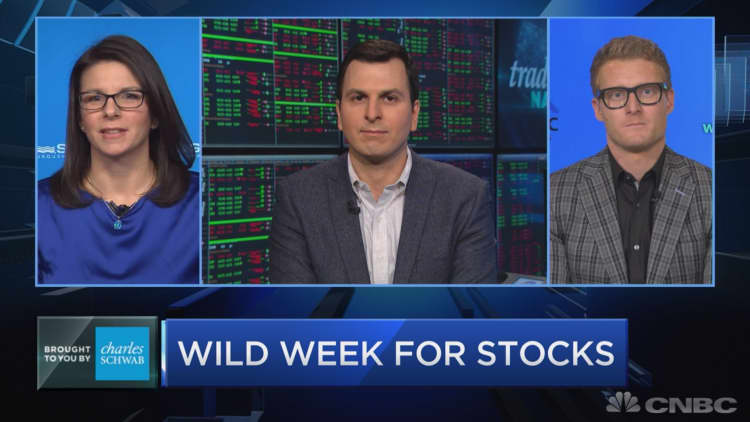
Volatility is back – and investors shouldn't expect it to go away anytime soon.
"We're entering a new normal," Mark Tepper of Strategic Wealth Partners said Friday on CNBC's "Trading Nation." "What investors need to do is just stay calm. Corrections like this typically happen every 13 months or so."
Volatility returned with force in the past week. The Dow started the week with its steepest point decline on record and ended the week having traveled more than 22,000 points over the five sessions. Meanwhile, the saw its steepest 10-day decline from all-time highs ever, breaking the record set in 1986, according to Bespoke. As stocks sold off, the VIX, which measures market volatility, spiked above 50, its highest level since August 2015. It had traded as low as 8.92 in early January.
Last week's losses attracted such anguish because these kinds of downward moves have become so infrequent over the past year. The VIX reached an all-time closing low on November 3 after dropping below its previous low reached in 1993. Low volatility made record highs easy to achieve with just small moves in the past year. The Dow ended 2017 having closed at all-time highs 71 times over the 12 months. That was its most records in one year, surpassing the previous record of 69 all-time closing highs set in 1995.
"A spike in volatility caused the stock market plunge, not the other way around," said Tepper. "When you look at the muted reaction of other risk gauges like junk bonds and emerging markets stocks, it's reasonable to believe that this is just a normal correction."
The return to volatility last week took Wall Street off guard, but now investors have come to expect far more waves as we head deeper into the year.
"The options market is certainly pricing in increased volatility going forward," said Stacey Gilbert, market strategist at Susquehanna Capital Group, on "Trading Nation." At the beginning of the year, the options market was pricing in a 1.5 percent move on the S&P 500 twice this year. Now, options suggest that kind of move twice a week.
"Options are really saying what was supposed to be somewhat of an outlier event is now going to be something that we're expected to see a lot more often," added Gilbert.
The S&P 500 moved by more than 1 percent four out of the five sessions last week and by as much as 4.1 percent last Monday. For the week, the S&P 500 declined 5.2 percent, its worst week since January 2016.
Expectations of increased volatility have led to a pricier options market. According to Gilbert, the price of protection as measured by a put option has risen nearly 3.5 times since the beginning of the year — it once cost $20, but now goes for around $75.
"That's really what the markets are pricing in here," said Gilbert. "There's increased risk. There's increased intraday movement."
Even with increased volatility, Tepper remains bullish on the S&P 500. He expects stocks to end the year higher and anticipates the S&P 500 surpassing 3,000 before the next recession. As of Monday's session, the index is 14 percent below that level.
Tepper isn't alone. The median year-end price target on the S&P 500 among brokerage firms sits at 3,000. UBS has the highest target and expects 3,150 by the end of 2018, and Morgan Stanley the lowest at 2,750.
"The proper strategy here is to buy the dip," said Tepper. "Now is the best time for investors to be repositioning their portfolios because the bull market isn't over."
Investors are already taking the cue on Monday. The Dow was up by more than 300 points at the session highs, while the S&P 500 added 0.8 percent.





